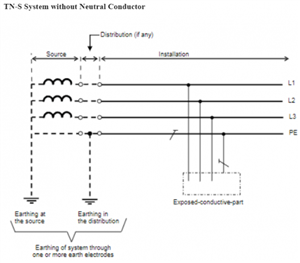Hello everyone,
What are the advantages/disadvantages of using TN-S system with and without Neutral conductors?. Where does it find its application?


Hello everyone,
What are the advantages/disadvantages of using TN-S system with and without Neutral conductors?. Where does it find its application?


There is no need for N if the three phases are perfectly balanced because no current would be flowing in it. However, if you don't put one in, you cannot then have single phase appliances downstream. The classical example is a machine with a three phase motor and a single phase lamp.
I suppose the disadvantage of putting in a N when you don't need it is that you are wasting resources.
Actually there are only a few cases where you would omit neutral and it is normally only in the last hop to a motor or some other thing that has no need for it.
Sometimes you find a 400v to 230 transformer down the back when they realized they needed it for the instrumentation or interlocks only after a 4 wire feed was fitted.
You may encounter 400v floodlights on big stadia that get two lives and no neutral, but that is all about the voltage drop and the size of the installation, to get the same number of KVA a greater distance. Its the same reason you occasionally see 690V/400 3 phase instead of 400/230 in really big factories, but in the UK that is quite rare.
(Germans seem to love it though, as well as a 1k2/690 variant, so mind your fingers when abroad.)
In general assume 5 wires, but note that neutral should carry less than the lives if the loads are well behaved.
Mike.
You can even connect single-phase loads to a 3-wire system without N - just as long as they run at 400V (rather than 230V) - occasionally found in things like floodlighting and welders.
Outside of 230/400V systems, you can have say 133/230V 3-phase systems and connect single-phase loads between two lines … much of the near continent used to favour such an approach for public supplies in the distant past.
- Andy.
The other place I have seen three phase without neutral is in large data centre where there is a real danger of large 3rd harmonic currents. In a worst case situation, (power supplies at 60% of full load) the 3rd harmonic in the neutral can be twice the phase current.
The remedy in some places is to put a delta star transformer at every distribution board and supply the transformer with 3 phase, no neutral. You then can't get 3rd harmonics on the main system.
It is not that the neutral is omitted.. in first case Neutral is combined with protective earth and in the second case , both are separate.
Perhaps it looks that way. But in TNS no loads will be connected between a Live and a protective earth (*), while a load current will flow in a neutral, if it is needed, as part of normal operation, not just during a fault.
TNS without neutral is not to be confused with TNC, where we do allow a shared neutral and earth, but at least in the UK, only permitted for distribution networks, and with additional precautions taken. - you cannot have an RCD-like function in a TNC system, as fault current and load currents share a wire.
Mike
(*) Well, it is sometimes seen actually, but is very naughty - load currents flowing in the earthing wiring are considered a very bad thing, and in a well designed system Automatic Disconnection of Supply (ADS) will operate in some form to remove the power should the earth current be more than a fraction of a percent of the full load current.
We're about to take you to the IET registration website. Don't worry though, you'll be sent straight back to the community after completing the registration.
Continue to the IET registration site